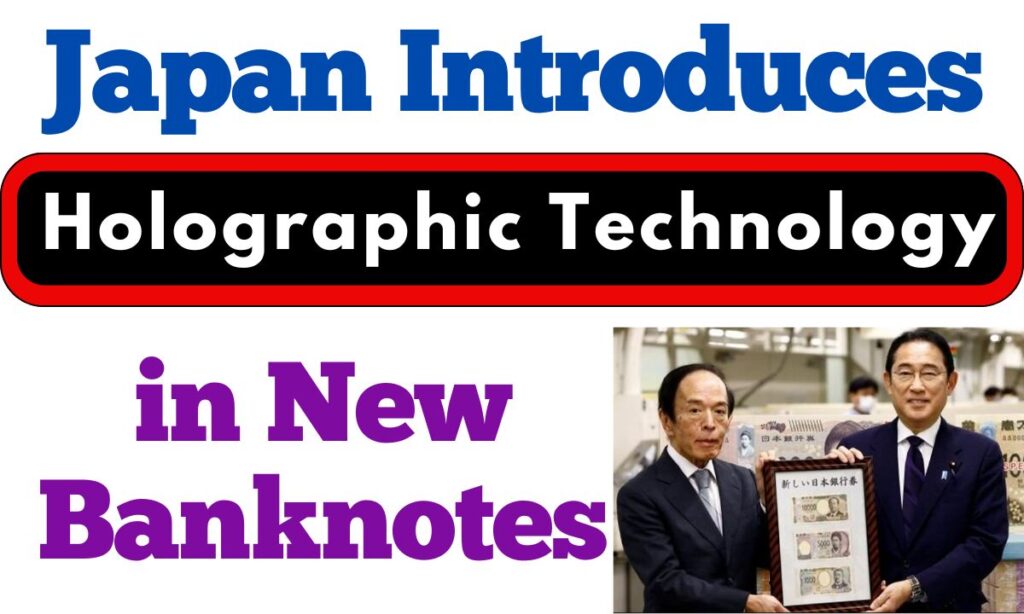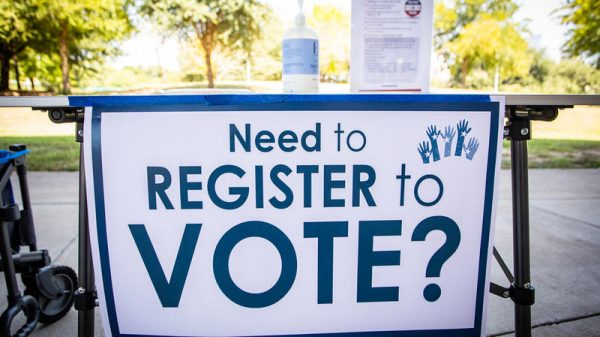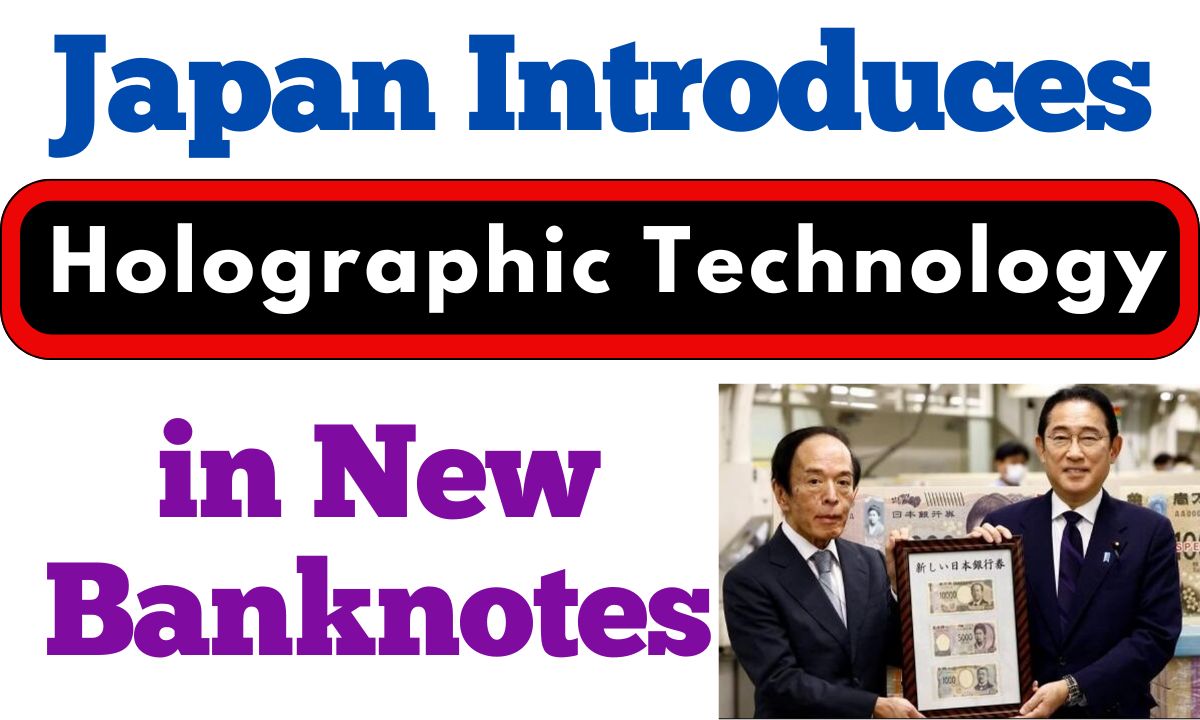What is Holographic Technology: Japan will launch new banknotes that will incorporate the world’s most advanced holography technology. This Holographic Technology will help prevent counterfeit notes and increase the security of financial transactions. The design and features of the Holographic Technology new banknotes will attract people.
On July 3, Japan will release new banknotes that will feature special advanced holography technology. This technology will show pictures of historical figures rotating in 3D on the notes. This is an important step to prevent counterfeiters. This is the first time in 20 years that Japan is changing the design of its banknotes.

Japan Introduces Holographic Technology New Banknotes
Japan will introduce new banknotes on July 3, which will use advanced holography, which is considered to be the world’s leading technology. These new banknotes have incorporated holographic images, which is an important step from the security point of view.
This Holographic Technology is considered highly effective in preventing counterfeit notes. This step of Japan is an important initiative towards making financial transactions even more secure and transparent. The design of Japan’s new banknotes and their features will also become a center of attraction for the public.
First Major Change in the Last Two Decades
Japan is going to introduce a new series of banknotes. This is the first major change in two decades. The new ¥10,000, ¥5,000, and ¥1,000 notes will have advanced technology that will help prevent counterfeit notes and will feature pictures of famous historical figures. Since 1885, Japan has created 53 different designs of its banknotes. This latest change, which will start on July 3, is made to increase security and usability.
Why The Change?
The main reason for this change is to make banknotes safer and prevent counterfeiting. The new holography technology will play a key role in this. Showing images moving in 3D will make it much harder to counterfeit notes. This will protect the economy and ensure that people only use real money.
With the new banknotes, Japan is taking a big step towards making its money safer by using modern technology. This change will not only help prevent counterfeit notes but will also reflect the country’s rich history, as it will feature portraits of important historical figures. This update is an important step to keep up with changing times and ensure the currency’s security for the future.
Japanese Holographic Technology New Notes Features
The upcoming banknotes in Japan will have several innovative features to prevent counterfeiting. Here are the main features:
Three-Dimensional Holographic Stripes
The ¥10,000 and ¥5,000 notes will have 3D holographic stripes. When you tilt these notes, the portraits will appear from different angles. The ¥1,000 note will also have a similar holographic patch at the bottom left corner.
Enlarged Arabic Numerals
The new notes will have larger Arabic numerals instead of kanji characters. This will make it easier for people of all ages and nationalities to recognize the face value.
Tactile Marks
The notes will include tactile marks to help visually impaired individuals identify the denominations by touch.
Intaglio Printing and Watermarks
The notes will feature intaglio printing and watermarks to enhance authenticity. These features make the notes more difficult to counterfeit.
First-of-Its-Kind Holography
Japan claims to be the first country to use holography that creates a 3D rotating effect on the portraits. This significantly improves the security of the notes.
Efforts to Combat Counterfeiting
These new features are part of Japan’s ongoing efforts to stop counterfeiting. Even though counterfeit cases have decreased over the years, it is still a concern. In 2020, there were 2,693 counterfeit cases reported, but in 2023, only 681 cases were reported.
With these new features, Japan aims to make its banknotes more secure and easier to use for everyone.
When And How You Will Get These New Notes?
The Japan new banknotes will be available from July 3, 2024. First, they will be distributed to financial institutions, which will then make them available to the public through ATMs and cashier windows.
By the end of March 2025, about 7.5 billion new banknotes are expected to be in circulation, with a total of 5 billion banknotes produced by the end of March 2024. The Japan old banknotes will remain valid for trade, while the new banknotes will be in circulation.
Historical Figures on Japanese Holographic Technology New Banknotes
The new banknotes will feature three important individuals who have been selected for their significant contributions to Japan.
¥10,000 note: Eiichi Shibusawa
The ¥10,000 note will feature Eiichi Shibusawa (1840-1931), known as the “father of Japanese capitalism.” Shibusawa played a key role in modernizing Japan’s economy during the Meiji period. He founded the First National Bank in 1873 and established major companies such as the Sapporo Brewery and Tokyo’s Imperial Hotel. The reverse of the ¥10,000 note will feature a red-brick image of Tokyo Station’s Marunouchi Building, symbolizing the progress and modernization that Shibusawa championed.

¥5,000 note: Umeko Tsuda
The ¥5,000 note will feature Umeko Tsuda (1864-1929), a pioneering educator. Tsuda devoted her life to expanding educational opportunities for women in Japan. After studying in the United States, she founded Tsuda University, one of Japan’s most prestigious women’s institutions. The reverse of the ¥5,000 note will feature Japanese wisteria flowers, symbolizing the beauty and permanence of Tsuda’s efforts.

¥1,000 note: Shiba Saburo Kitasato
The ¥1,000 note will honour Shiba Saburo Kitasato (1853-1931), a leading bacteriologist. Kitasato gained fame for his contributions to world medicine. He discovered an antiviral for diphtheria and played a key role in the development of Japanese medical science. The reverse of the ¥1,000 note will feature the “Great Wave of Kanagawa,” a famous woodcut by Ukiyo-e artist Katsushika Hokusai, which reflects Kitasato’s influence on global science and medicine.

-
Hello Friends I am writing since 2020. I have done MBA in Finance, and worked in one of the top Private Bank. Currently i am fully focusing on writing Finance related information. My aim is to provide correct and useful data to all of you. If You find any mistake or misinformation in my articles then you can contact me.
View all posts




![Tyson Foods Plant [Photo: Food Manufacturing]](https://southarkansassun.com/wp-content/uploads/2023/08/iStock_1185520857__1_.5e441daa51cca-600x337.jpg)








![Silverado Senior Living Management Inc. [Photo: Los Angeles Times]](https://southarkansassun.com/wp-content/uploads/2023/10/download-6-4-600x337.jpg)

![China's Wuhan Institute of Virology [Photo: Nature]](https://southarkansassun.com/wp-content/uploads/2023/09/d41586-021-01529-3_19239608-600x337.jpg)















